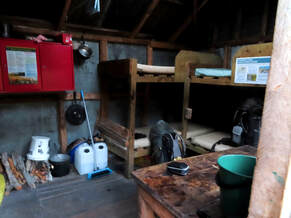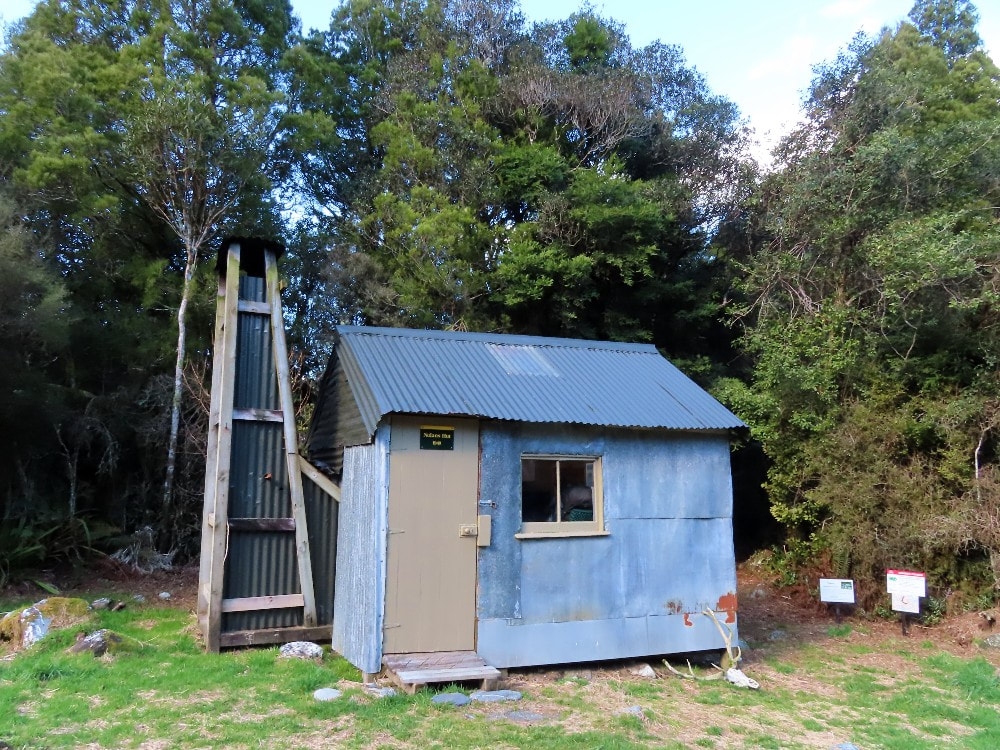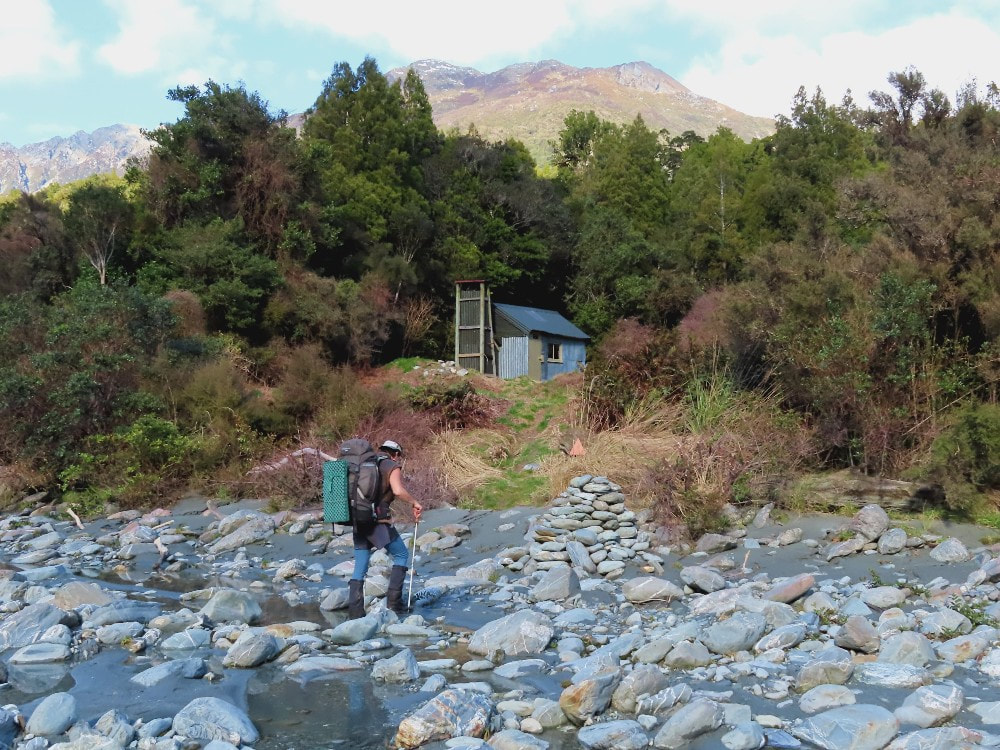Nolans Hut
 Looking up the Perth to the Great Unknown from below Hughes Creek
Looking up the Perth to the Great Unknown from below Hughes Creek
Maintenance Status
Nolans Hut is an old musterers hut that is now community-maintained. Kevin Hansen of Whataroa has been keeping an eye on the place since DOC took over from the NZFS in the mid-1980s and when the department started making noises about removing Nolans in the early 2000's (they considered it to be more or less derelict), Kevin had other ideas about that. He's done two lots of maintenance in the ensuing years and over that period DOC has embraced community input on low-use huts on public conservation land. Retaining Nolans has turned out to be an asset not only for trampers and hunters but also as one of the bases for the Zero Invasive Predators project. ZIP has been pretty much successful in eradicating stoat, possums and rats from the upper Perth catchment and has expanded the project to the Butler Range behind Nolans Hut. The tracks in the Perth are DOC maintained, although Permolat volunteers did help out by doing a bit of minor detour work in 2020.
Location
Perth catchment. Map BW16. Grid Ref: E1395948/ N5197430. Altitude 180m. Nolans Hut is located at the bottom end of the river flat of the same name in the lower Perth valley. The scenery in the area can only be described as magnificent, and the terrain is some of the roughest in the land. Nolans flat was grazed from quite early on by farmers who drove cattle up the valley and over the river terraces on the TL of the Perth from the Whataroa confluence. This would have been no mean feat. The cattle are long gone, leaving the valley to a steady trickle of hunters, trampers, and alpinists. The Perth is one of the key access routes to the Garden of Eden and Garden of Allah ice plateaus and Nolans is often the first stopover on this journey. Nolans is often overlooked by hunters for whom the main attraction is Himalayan Tahr in the upper valley. There are plenty of these on the Butler Range behind the Hut although few would be game these days to tackle Hughes Creek on foot to get up there. There are reasonable numbers of deer around Nolans Flat and chamois are regularly encountered at river level.
Access
Nolans Hut can be accessed in 4-5 hours from the Whataroa roadend by a reasonably fit party. The lower Whataroa is a mix of track and river travel with the river flats still being grazed as far as Alf Creek. A bush track takes you from here to the swingbridge above the Perth confluence. Once on the TR the track climbs steeply past the Butler Junction turnoff onto a bush terrace which is followed for a good hour before dropping to the Perth downstream of Hughes Creek. Ford the Creek and at low flows continue upriver to Nolans, otherwise make use of a small bush detour up and over some shingle bluffs. The track is currently in good condition. Although the Whataroa is bridged, Big Creek, Alf Creek, and Hughes Creek are big ones and uncrossable after heavy rain, particularly the latter.
Nolans Hut is an old musterers hut that is now community-maintained. Kevin Hansen of Whataroa has been keeping an eye on the place since DOC took over from the NZFS in the mid-1980s and when the department started making noises about removing Nolans in the early 2000's (they considered it to be more or less derelict), Kevin had other ideas about that. He's done two lots of maintenance in the ensuing years and over that period DOC has embraced community input on low-use huts on public conservation land. Retaining Nolans has turned out to be an asset not only for trampers and hunters but also as one of the bases for the Zero Invasive Predators project. ZIP has been pretty much successful in eradicating stoat, possums and rats from the upper Perth catchment and has expanded the project to the Butler Range behind Nolans Hut. The tracks in the Perth are DOC maintained, although Permolat volunteers did help out by doing a bit of minor detour work in 2020.
Location
Perth catchment. Map BW16. Grid Ref: E1395948/ N5197430. Altitude 180m. Nolans Hut is located at the bottom end of the river flat of the same name in the lower Perth valley. The scenery in the area can only be described as magnificent, and the terrain is some of the roughest in the land. Nolans flat was grazed from quite early on by farmers who drove cattle up the valley and over the river terraces on the TL of the Perth from the Whataroa confluence. This would have been no mean feat. The cattle are long gone, leaving the valley to a steady trickle of hunters, trampers, and alpinists. The Perth is one of the key access routes to the Garden of Eden and Garden of Allah ice plateaus and Nolans is often the first stopover on this journey. Nolans is often overlooked by hunters for whom the main attraction is Himalayan Tahr in the upper valley. There are plenty of these on the Butler Range behind the Hut although few would be game these days to tackle Hughes Creek on foot to get up there. There are reasonable numbers of deer around Nolans Flat and chamois are regularly encountered at river level.
Access
Nolans Hut can be accessed in 4-5 hours from the Whataroa roadend by a reasonably fit party. The lower Whataroa is a mix of track and river travel with the river flats still being grazed as far as Alf Creek. A bush track takes you from here to the swingbridge above the Perth confluence. Once on the TR the track climbs steeply past the Butler Junction turnoff onto a bush terrace which is followed for a good hour before dropping to the Perth downstream of Hughes Creek. Ford the Creek and at low flows continue upriver to Nolans, otherwise make use of a small bush detour up and over some shingle bluffs. The track is currently in good condition. Although the Whataroa is bridged, Big Creek, Alf Creek, and Hughes Creek are big ones and uncrossable after heavy rain, particularly the latter.
 Original hut inscription
Original hut inscription
Type and History
Nolans is a one-off product of the mustering era with four bunks, an open fire, and a single paned window. The frame and floor are totara sawn from the locality and the walls flat iron cladded. On the inner wall below the window, it's inscribed that the Hut was erected by Terence J. (Jim) Nolan and Jack Burke in 1949. Kevin's mother was a Nolan, and he says there was already a hut further back on the terrace built around 1920 by Gus Havill, the original runholder. Ebenezer Teichelmann, the mountaineer and photographer, visited it in 1924 on a trip to cut a track up to Scone Creek that would allow access to the Gardens. Jim took over the grazing lease from Gus and shifted the hut down to the river in 1949. The NZFS took over the maintenance of the huts and tracks the valley in the 1950's and built Scone Hut in the early 1960's. In 1978 Mike McIver and Barry Perrin of the FS did some maintenance on Nolans, replacing a few of the original floorboards, and the bunk sacking with wooden slats. In 2004, around the time DOC started muttering about removal, Kevin went in and re-piled the Hut, replaced joists and re-roofed it with 2nd hand iron. In 2021 he went in again and rebuilt the chimney and fire surround, put a new door on, painted the roof, and fixed a windowpane. DOC have erected a toilet on the site and have kindly offered to reimburse Kevin for material costs. Water is from the river.
Nolans is a one-off product of the mustering era with four bunks, an open fire, and a single paned window. The frame and floor are totara sawn from the locality and the walls flat iron cladded. On the inner wall below the window, it's inscribed that the Hut was erected by Terence J. (Jim) Nolan and Jack Burke in 1949. Kevin's mother was a Nolan, and he says there was already a hut further back on the terrace built around 1920 by Gus Havill, the original runholder. Ebenezer Teichelmann, the mountaineer and photographer, visited it in 1924 on a trip to cut a track up to Scone Creek that would allow access to the Gardens. Jim took over the grazing lease from Gus and shifted the hut down to the river in 1949. The NZFS took over the maintenance of the huts and tracks the valley in the 1950's and built Scone Hut in the early 1960's. In 1978 Mike McIver and Barry Perrin of the FS did some maintenance on Nolans, replacing a few of the original floorboards, and the bunk sacking with wooden slats. In 2004, around the time DOC started muttering about removal, Kevin went in and re-piled the Hut, replaced joists and re-roofed it with 2nd hand iron. In 2021 he went in again and rebuilt the chimney and fire surround, put a new door on, painted the roof, and fixed a windowpane. DOC have erected a toilet on the site and have kindly offered to reimburse Kevin for material costs. Water is from the river.
 Hut interior
Hut interior
Condition
I'd have to say that in my early visits to Nolans in the 1980's the Hut didn't hold a great deal of appeal for me, being somewhat dingy, and having an active sandfly and rodent population. Kevin's efforts over the years have dealt with a lot of this and turned it into a relatively comfy and cosy little time capsule with great old-world ambience. The total absence of rats during my last visit in 2022 is a testament to the success of the ZIP operation. Currently the hut is in very good shape. Someone has mentioned rain blowing in down the chimney and Kevin was contemplating lowering the cap. On our visit in August 22, the area in front of the hearth was dry and so this may not be necessary.
I'd have to say that in my early visits to Nolans in the 1980's the Hut didn't hold a great deal of appeal for me, being somewhat dingy, and having an active sandfly and rodent population. Kevin's efforts over the years have dealt with a lot of this and turned it into a relatively comfy and cosy little time capsule with great old-world ambience. The total absence of rats during my last visit in 2022 is a testament to the success of the ZIP operation. Currently the hut is in very good shape. Someone has mentioned rain blowing in down the chimney and Kevin was contemplating lowering the cap. On our visit in August 22, the area in front of the hearth was dry and so this may not be necessary.
 Hughes Creek looking up to Mt. Whataroa
Hughes Creek looking up to Mt. Whataroa
Routes
Scone Hut in the upper valley can be accessed in 3-5 hours from Nolans depending on the conditions and the route chosen. The tracks are in excellent condition currently but not all are needed when the river is low. From Nolans head up the flat to the first shingle bluff. There is a detour track around it which currently isn't necessary at normal flows. After Pauline Stream there is a short and very steep climb to get around a small gorge. In the past we've been able to avoid it at normal river flows by wading through the gorge, but in 2022 the river had changed, and this wasn't possible. Above the gorge the track heads back up onto the terrace and there follows around 3kms of undulating and tedious travel. It makes more sense and is far quicker currently just to follow the riverbed, which is a fairly easy mix of flats and boulder travel. Around 1km downriver from Five Finger Stream the track can be picked up again and followed to the Scone.
Hughes Creek is negotiable but has been heavily eroded by successive extreme weather events. Travel gets trickier at around the 530m contour and a scrub bash on the TL is required around a gorgy section to get to where the creek branches. In late summer and autumn Tohunga Peak is a steep scramble up the side creek that drains the low point between it and Mt. Whataroa. At other times, or to get from Tohunga further east, you're going to need climbing gear and skills. There was mention in the Nolans hutbook of a circuit someone did up Dry Creek and over and down via the TR branch of Hughes Creek.
Alpinists heading upvalley usually go via Scone Hut, the upper Perth, and Redfield Creek to gain access to the Great Unknown and the Gardens. Another route that is worth considering and more direct is via the second (unnamed) side-creek upriver from where the Barlow enters the Perth. The bottom end of the creek is a bit rugged but can be negotiated on its TR. Further up it is actively eroding but relatively open travel all the way to Point 1896m.
Repairs Needed
No major ones at the moment. The chimney cap could be lowered if necessary.
Provisions on site
The Hut has a supply of billies, pans, buckets and basins. There is a broom, a hearth brush and shovel, and an axe, and several plastic water containers. There is a steel wall mounted cabinet for storage.
Scone Hut in the upper valley can be accessed in 3-5 hours from Nolans depending on the conditions and the route chosen. The tracks are in excellent condition currently but not all are needed when the river is low. From Nolans head up the flat to the first shingle bluff. There is a detour track around it which currently isn't necessary at normal flows. After Pauline Stream there is a short and very steep climb to get around a small gorge. In the past we've been able to avoid it at normal river flows by wading through the gorge, but in 2022 the river had changed, and this wasn't possible. Above the gorge the track heads back up onto the terrace and there follows around 3kms of undulating and tedious travel. It makes more sense and is far quicker currently just to follow the riverbed, which is a fairly easy mix of flats and boulder travel. Around 1km downriver from Five Finger Stream the track can be picked up again and followed to the Scone.
Hughes Creek is negotiable but has been heavily eroded by successive extreme weather events. Travel gets trickier at around the 530m contour and a scrub bash on the TL is required around a gorgy section to get to where the creek branches. In late summer and autumn Tohunga Peak is a steep scramble up the side creek that drains the low point between it and Mt. Whataroa. At other times, or to get from Tohunga further east, you're going to need climbing gear and skills. There was mention in the Nolans hutbook of a circuit someone did up Dry Creek and over and down via the TR branch of Hughes Creek.
Alpinists heading upvalley usually go via Scone Hut, the upper Perth, and Redfield Creek to gain access to the Great Unknown and the Gardens. Another route that is worth considering and more direct is via the second (unnamed) side-creek upriver from where the Barlow enters the Perth. The bottom end of the creek is a bit rugged but can be negotiated on its TR. Further up it is actively eroding but relatively open travel all the way to Point 1896m.
Repairs Needed
No major ones at the moment. The chimney cap could be lowered if necessary.
Provisions on site
The Hut has a supply of billies, pans, buckets and basins. There is a broom, a hearth brush and shovel, and an axe, and several plastic water containers. There is a steel wall mounted cabinet for storage.



